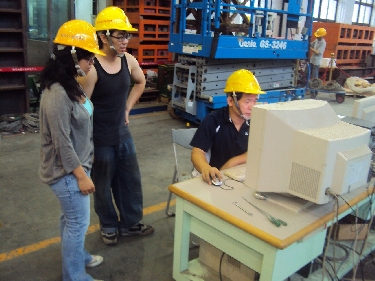Far from Home, Undergrads Contribute to Earthquake Research
August 22, 2011 / By Maureen C. Curran
San Diego, CA, Aug. 22, 2011 — The research opportunity of a lifetime is coming to a close for nearly two dozen undergraduates who have had summer research adventures which took them thousands of miles from home as part of a unique international summer research program at the University of California, San Diego. Three of these students investigated earthquakes in locations that are part of the Pacific Ring of Fire, an area of the world touching several continents surrounding the Pacific Ocean where large numbers of earthquakes and volcanic eruptions occur.
Sean Luong, a structural engineering major, and Chris Manco, a civil engineering major, went to the University of Auckland, New Zealand. They have just completed their project which included the opportunity to participate in a field investigation, where they gathered structural and geotechnical details on existing bridges in Christchurch, New Zealand. This area of New Zealand (on the South Island) has been wracked by recent earthquake activity. Since the devastating September 4, 2010 7.1 magnitude (M) Darfield earthquake, Christchurch and surrounding areas have had more than two dozen aftershocks of 5.0 M or more, the worst of which was on February 22, 2011 (6.3 M), which caused over 180 deaths.
|
The students' trip to Christchurch was both educational and eye-opening. "It was really interesting to be able to visit Christchurch," said Sean Luong, "Basically, the entire city center is closed off to the public, most people have evacuated the surrounding areas and there are a lot of abandoned/broken homes and buildings. It is a very sad sight to see."
Added Chris Manco: "Many streets are desolate; while some of the homes contained only internal damage, others were leaning towards one side or had large cracks and gaps between the walls and the ground. From an engineering standpoint, it was interesting to see how the houses fared, but I have sympathy for all the families that were forced to pack up and leave their homes and jobs."
|
Luong and Manco's project involved summarizing the characteristics and damage of bridges as a result of the multiple earthquakes. They were out in the field, visiting each bridge: collecting concrete bridge samples, taking measurements and pictures of bridge displacements and rotations, and taking note of damage progression. Before going to Christchurch they had summarized the bridge characteristics using the bridge plans and determined the foundation characteristics. They have created a detailed database that will be used in the coming months to model the response of each bridge to lateral spreading loads from earthquakes. "This will help to inform decisions on the retrofit or replacement of these bridges," noted Liam Wotherspoon, a research fellow in the department of Civil and Environmental Engineering at The University of Auckland, who was their mentor there. Students in the Pacific Rim Undergraduate Experiences (PRIME) program each have two mentors (leading researchers in the field), one at their host institution and another back at UC San Diego.
Lelli Van Den Einde, their UCSD mentor, pointed out the uniqueness of their opportunity, "Being able to participate on a reconnaissance mission following an earthquake is something many earthquake engineers (including me) dream of having the opportunity to do." She is a faculty lecturer in UCSD's department of Structural Engineering.
|
"I believe this experience for Sean and Chris demonstrated the significance an earthquake can have not only on structural systems, but on the community," she explained. "They learned so much more about earthquake engineering and the technical requirements needed to design resistance to future earthquakes than any of my students can learn in a class. This program will impact them profoundly as they pursue their future careers as engineers."
"I think that PRIME is an excellent program, and the students that have come to Auckland in the last three years have all been excellent," said Wotherspoon. "PRIME gives students a new perspective on their field of study, as well as how research environments differ from country to country. The cultural experience is just as important as the academic side of this exchange and will prove invaluable as they move forward in their life and career."
The highly successful PRIME program, in its eighth year, provides undergraduates with hands-on research experiences in internationally collaborative settings. Against the backdrop of living abroad in another culture, this year's 23 undergrads are working as full-time researchers in one of 11 host laboratories located in countries across the Pacific Rim. The students receive cultural awareness preparation before they depart. All of the PRIME 2011 undergraduates are from UC San Diego, except Chris Manco, who is from the University of Delaware. This year, PRIME collaborated with the Network for Earthquake Engineering Simulation (NEES) in a pilot sending earthquake engineering students from outside of UCSD on the PRIME experience. Manco is the first. PRIME and NEES hope to expand this in the future.
|
PRIME is unique in its goal of developing culturally competent researchers for the emerging international scientific workplace. "We are immersing the students in both scientific research and a new culture in order to provide them with experiential training in both the conduct of research and the international global workplace," said Gabriele Wienhausen, PRIME's principal investigator and cofounder (with Peter Arzberger). Wienhausen is the associate dean of education for the UC San Diego Division of Biological Sciences.
PRIME gives students a wider view of the world and their place in it. "I've learned so much during my stay here [in Taiwan], not just educationally but culturally as well," Monica Chan, PRIME 2011, said, "I loved being able to experience Taiwanese life and culture in a way that I would otherwise not have been able to. In that sense, my experience here is much different than if I had interned back home."
Chan, a structural engineering major, is working on a project which reflects recent trends in earthquake engineering research which are focusing on investigating how nonstructural components behave following a seismic event. She is spending the summer at the National Center for Research on Earthquake Engineering (NCREE) in Taipei, Taiwan. Keng-Chang Kuo of NCREE is her host mentor; Van Den Einde is her UCSD mentor.
|
"For many years, people have been so concerned about the overall structure collapsing during an earthquake that they never considered how nonstructural components, such as utilities or sprinkler systems while not a part of the structural integrity of the building, are important to remain operational following an earthquake," said Van Den Einde.
Chan's experiments tested elements of a hospital sprinkler system for strength as part of a larger ongoing project based on an incident which occurred during last year's earthquakes in southeast Taiwan (March and April 2010, 6.4 M and 6.7 M). The piping system in one of the rooms in the hospital failed during the earthquake causing damage and subsequent leakage; this resulted in reduced functionality of the hospital. The project is modeling the room and investigating the seismic performance of the entire sprinkler system. Chan is sorry that she will not be there for the full testing of the piping system which is set for after her return home.
Chan summed up the feelings of many PRIME students: "One of the best things about my experience in PRIME is being able to work with other researchers in a different part of the world. PRIME offered me a unique opportunity to gain practical experience in my field as well as contribute to the advancement of global collaborative research."
Related Links
Media Contacts
Maureen C. Curran, mcurran/at/ucsd.edu, (858) 822-4084







